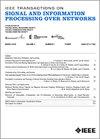A Generic Framework for Fixed-Time Synchronization of Large Delayed Impulsive Neural Networks
IF 3
3区 计算机科学
Q2 ENGINEERING, ELECTRICAL & ELECTRONIC
IEEE Transactions on Signal and Information Processing over Networks
Pub Date : 2025-04-16
DOI:10.1109/TSIPN.2025.3561551
引用次数: 0
Abstract
This article investigates fixed-time synchronization (FxTS) for neural networks with delayed impulses. There are two main challenges associated with the delay in this area. One is that it causes the networks to oscillate close to the equilibrium. The other is that it causes the synchronization criterion to be very conservative, particularly when the impulses contain large (exceeding impulsive intervals) delays. To overcome these challenges, we propose the concept of equivalent impulsive sequence and the method of delayed impulsive sequence decomposition, respectively. Meanwhile, we establish a framework that equivalently transforms the networks with large delays into a collection of networks with small (shorter than impulsive intervals) delays. Particularly, this transformation is a sufficient and necessary condition, and thus does not induce any conservatism. Following this, we delineate the FxTS criteria for the networks containing synchronizing and desynchronizing impulses. Interestingly, it is shown that under some conditions, the large delay has no effect on the FxTS criterion of networks with synchronizing impulses, but destroys those of networks with desynchronizing impulses. Furthermore, we prove the necessity and rationality of the FxTS criterion. Finally, the conclusions are substantiated through numerical demonstrations.大延迟脉冲神经网络固定时间同步的通用框架
本文研究了具有延迟脉冲的神经网络的定时同步问题。与这一领域的延误有关的主要挑战有两个。一是它使网络在接近平衡状态时振荡。另一个原因是它导致同步准则非常保守,特别是当脉冲包含大(超过脉冲间隔)延迟时。为了克服这些挑战,我们分别提出了等效脉冲序列的概念和延迟脉冲序列分解的方法。同时,我们建立了一个框架,将具有大延迟的网络等效地转换为具有小(小于脉冲间隔)延迟的网络集合。特别是,这种转变是一个充分必要条件,因此不会产生任何保守性。在此之后,我们描述了包含同步和去同步脉冲的网络的FxTS标准。有趣的是,在某些条件下,大延迟对具有同步脉冲的网络的FxTS准则没有影响,但破坏了具有非同步脉冲的网络的FxTS准则。进一步证明了FxTS准则的必要性和合理性。最后,通过数值验证对所得结论进行了验证。
本文章由计算机程序翻译,如有差异,请以英文原文为准。
求助全文
约1分钟内获得全文
求助全文
来源期刊

IEEE Transactions on Signal and Information Processing over Networks
Computer Science-Computer Networks and Communications
CiteScore
5.80
自引率
12.50%
发文量
56
期刊介绍:
The IEEE Transactions on Signal and Information Processing over Networks publishes high-quality papers that extend the classical notions of processing of signals defined over vector spaces (e.g. time and space) to processing of signals and information (data) defined over networks, potentially dynamically varying. In signal processing over networks, the topology of the network may define structural relationships in the data, or may constrain processing of the data. Topics include distributed algorithms for filtering, detection, estimation, adaptation and learning, model selection, data fusion, and diffusion or evolution of information over such networks, and applications of distributed signal processing.
 求助内容:
求助内容: 应助结果提醒方式:
应助结果提醒方式:


